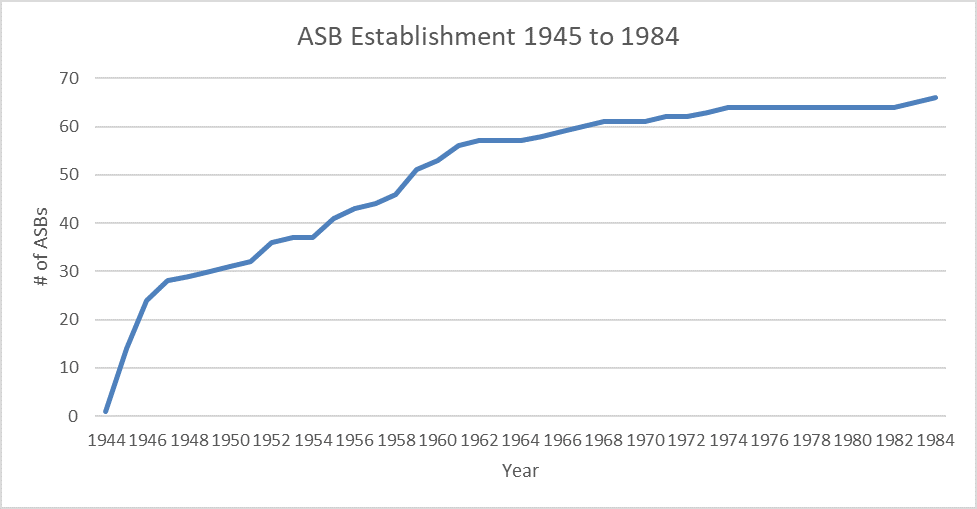Government mail service may be affected by the Canada Post labour disruption. Learn about how critical government mail will be handled.
A changing industry
Agricultural Service Boards (ASBs) are unique to Alberta. In 2019 ASBs celebrated 75 years of continuous service to producers in Alberta. ASBs were first established as a pilot project in 1943.
Between the 1920s and 1930s, agriculture was developing rapidly as markets were strong. Immigration into Alberta – especially the Prairies – was at an all-time high. During this time, expansion in industry as mechanization began to take off with the advancement of technologies in tractors and harvesting equipment.
This all changed in the 1930s. Not only did the markets crash but there was an epic drought that resulted in many Alberta farms being abandoned. Understandably, municipalities and provincial district agriculturalists became overwhelmed. The Province inspectors in the 1940s realized that municipalities were closest to problems and could deal with requests or issues more quickly than provincial inspectors could.
1943 pilot project
In 1943, the municipal district (M.D.) of Conrich (now called Rocky View County) and the County of Red Deer joined forces and initiated a pilot project where special agricultural committees were set up. Each committee consisted of 2 councillors, 2 farmers, and the district agriculturist. These 2 committees operated with partial funding from Alberta Agriculture. As a result of the success of the pilot project, a resolution was passed at the municipal districts convention in Calgary, in November 1944.
The resolution read:
"Be it resolved that this conference endorse and recommend the establishment of ASBs in all municipal districts, such boards to be similar to personnel and objectives as the one established in the M.D. No. 220 and now in operation and that legislation as may be considered necessary be enacted by the Legislature to authorize the formation of such boards and to designate their powers."
Formation of ASBs
In response to the 1944 resolution, the Agricultural Service Board Act was drafted and passed into Alberta Legislation in the spring of 1945. The Act assigned specific duties and powers to both municipal and provincial partners, while encouraging a cooperative and coordinated effort in the development of agricultural policies and programs that were of mutual benefit.
Rural municipalities responded to the new legislation in accordance with agricultural needs and available budget. From 1945 to 1947, activities under the ASB Act focused on weed and brush control and soil conservation. As the years have passed, the role of ASBs has expanded to include a variety of programs to service Alberta’s agriculture industry.
The ASB Act was revised in 1997 and became more enabling, allowing council to determine the structure of the board and its membership. This allowed some council to include local famers (members at large) to be members of ASB.
Farmers embraced the ASB program as the boards were now composed of their peers who knew the localized issues. The Boards had the authority to work directly with farmers to reclaim land and bring it back to a productive state. Also, farmers were in the driver’s seat at last and were able to develop and influence municipal policies, and had legislated influence with the Ministry of Agriculture.
The program started off strong after the legislation passed. In 1945, there were 14 municipalities with ASBs (20%), then another 10 joined in 1946 (35%). By 1960, 70% of municipalities had ASBs. They reached 91% by the early 1970s and by the 2000s all eligible 69 rural municipalities had an ASB.
Figure 1. ASB Establishment 1945 to 1984

Today the 69 ASBs in Alberta help nearly 60,000 farms and ranches to protect the over 50 million acres they farm. While ASBs continue to partner with Alberta government, they have become more independent from the province in their programming. As before, programs focus on weed and pest control but also include grants and environmental and sustainable agriculture programs.
For more information on Agricultural Service Boards, see ASB Overview.
Agricultural Fieldmen
Agricultural Fieldmen were appointed and hired shortly after the ASB Act was implemented in 1945. As per the ASB Act, an Agricultural Fieldman is a qualified person hired by the council and employed on a full-time basis. Once a council has established a board, they must appoint a qualified person as an Agricultural Fieldman to implement agricultural policies and programs and to manage the agricultural resources of the municipality.
In the beginning, fieldmen worked mostly in the field, often in collaborating with the local Alberta Agriculture District Agriculturist. Fieldmen were responsible for the implementation of the Acts and did the majority of weed and pest control.
Today, the core areas of expertise of fieldmen remain weed control, soil and water resource conservation, and pest management. Their roles have evolved, with many fieldmen having more administrative and supervisory roles. They often oversee seasonal inspection teams who handle more of the inspection, surveillance and other field work.
Agricultural Fieldmen also maintain membership in the Association of Alberta Agricultural Fieldmen (AAAF). As AAAF members, they meet annually for training and to conduct association business.
Contact
Connect with ASB unit staff:
Hours: 8:15 am to 4:30 pm (open Monday to Friday, closed statutory holidays)
Phone: 780-980-4878
Toll free: 310-0000 before the phone number (in Alberta)
Fax: 780-422-7755
Mailing address:
Agricultural Service Board Program
106 Provincial Building
4709 44 Avenue
Stony Plain, Alberta T7Z 1N4